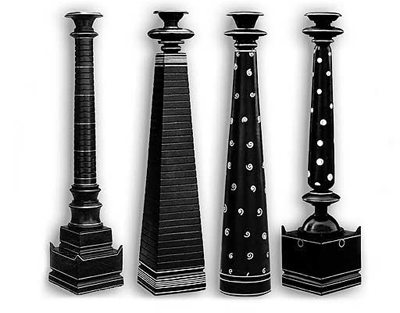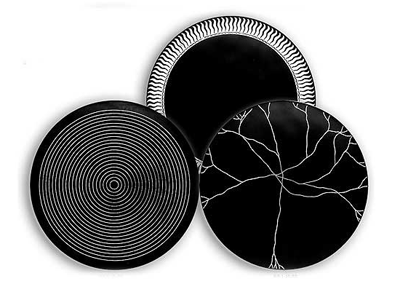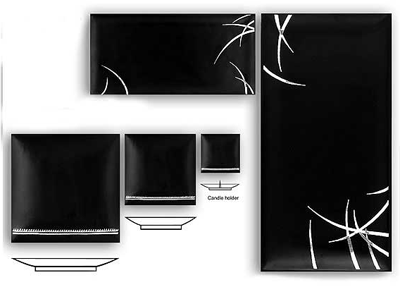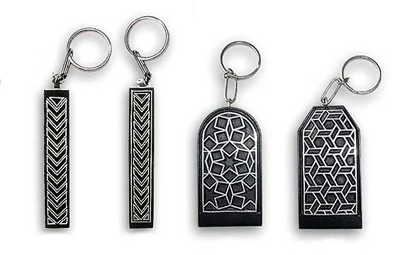I have never seen such cotemporary renderings of a traditional art and craft.
The modern twist to Bidri work is simply stunning.
The art of inlaying silver in a dark metal is called Bidri.
The designers Suryaprakash Gowda and Vikram Sardesai are among those who define modern Indian lines.
Bidri candle stands
Bidri plates
These Indian designers based in Bengaluru, with their dedicated team under the name of Design Core India take lacquer work, stone inlay and Bidri work from traditional Indian handicraft and adapt it in such a way that the final product becomes breath-taking!
Bidri candle holders and trays
Bidri Keychains
Elegance of these stone inlay work is indesciable ?
stone inlay plates
stone inlay plates
While you are on their website do not miss lacquer work . Their recycled products are a different story altogether. I am doing that but a little later.
To know actual process of Bidri work (in detail) and links to traditional Bidri work keep reading…
Bidri is metal decorative objects ornamented with a type of Indian inlay work with silver. The basic material used is an alloy of 94% zinc and 6% copper.
The handicraft derives its name from the town of Bidar, in Karnataka. Except Bidar, Lucknow and Murshidabad are also very important centres of Bidri manufacture.
Each Bidri piece is cast separately from ordinary soil made malleable with castor oil and resin. A mold is formed and the molten metal alloy is then poured into it. The surface to be adorned is smoothened with files and scrappers. Then the artist rubs the piece with a bit of copper sulphate to obtain a temporary black coating on which to etch the design and the free-hand pattern to be inlaid is chiseled out with a metal stylus. The craftsman hammers fine silver wire or flat sheeting into the engraved area.On buffing, the entire surface, including the silver inlay, glows evenly. You cannot see the pattern as yet.
Now the Bidri item is ready for the final step of making the surface permanently black so that the silver inlay design will stand out in bright contrast against the dark background. There is a particular type of soil found in the inner depths of ruins which are three hundred years old, in buildings where neither sunlight nor rain has fallen for hundreds of years. This soil, when mixed with ammonium chloride and water, produces a very special paste which is rubbed onto the heated Bidri article.
The paste darkens the body of the piece, but has no effect on the silver inlay. As the paste is rinsed off, the design springs dramatically into view, the shining silver resplendent against the black surface. Finally oil is rubbed to deepen the background and show off the polished silver in contrast. Craftsmen do this work traditionally by the use of five types of tools. No machine is used and is solely done by hand.
With proper maintenance, Bidri items can be kept bright and beautiful indefinitely. Use silver polish to shine the silver inlay. Then rub pure vegetable oil over the entire surface. Water will not harm Bidri piece but soap and salt should be avoided as they can spot the thin black surface.






Would Like to speak to you about the Bidri work . Please get in touch Mr Sardesai .. absolutely love your work and want to speak with you about some craft related projects .
Thanks and looking forward to hearing back
Aradhana
9820302195
love your blog and thanks this is amazing info great work !!!
We must use more recycled products in order for us to reduce the garbabe problem that we have.,~
hi..
i like your’s works, is simply and elegant
this is all made by stone?
cheers
hi
i am thoroughly impressed by your designs. do you retail your products in bombay ?if yes, then where? i am specially interested in the bidri plates – are they meant to be used as dinnerware? what about toxicity, usage of soap and water? also how to maintain the look? what about the stone inlay plates – can they be used as dinnerware?
Could you pls. give me ure address & contact number.
Dear Mr.Viki,
I love your work. I am a designer too and I have made some contemporary designs for bidri. I want your guidance in how to take my work further. I want to know how i can get in touch with you.
Please guide me.
Preeta
Thanks Viki ji.
Tyo,
Hope you have your answer now!
Hi !
The base stone is usually white or black marble. I use mother-of-pearl, shankh (conch shell), burnt Jaisalmer, green marble and some semi-precious stones for the inlays…
Viki